Receptor protein tyrosine phosphatase beta/zeta is a functional binding partner for vascular endothelial growth factor
- PMID: 25644401
- PMCID: PMC4323219
- DOI: 10.1186/s12943-015-0287-3
Receptor protein tyrosine phosphatase beta/zeta is a functional binding partner for vascular endothelial growth factor
Abstract
Background: Receptor protein tyrosine phosphatase beta/zeta (RPTPβ/ζ) is a chondroitin sulphate (CS) transmembrane protein tyrosine phosphatase and is a receptor for pleiotrophin (PTN). RPTPβ/ζ interacts with ανβ₃ on the cell surface and upon binding of PTN leads to c-Src dephosphorylation at Tyr530, β₃ Tyr773 phosphorylation, cell surface nucleolin (NCL) localization and stimulation of cell migration. c-Src-mediated β₃ Tyr773 phosphorylation is also observed after vascular endothelial growth factor 165 (VEGF₁₆₅) stimulation of endothelial cells and is essential for VEGF receptor type 2 (VEGFR2) - ανβ₃ integrin association and subsequent signaling. In the present work, we studied whether RPTPβ/ζ mediates angiogenic actions of VEGF.
Methods: Human umbilical vein endothelial, human glioma U87MG and stably transfected Chinese hamster ovary cells expressing different β₃ subunits were used. Protein-protein interactions were studied by a combination of immunoprecipitation/Western blot, immunofluorescence and proximity ligation assays, properly quantified as needed. RPTPβ/ζ expression was down-regulated using small interference RNA technology. Migration assays were performed in 24-well microchemotaxis chambers, using uncoated polycarbonate membranes with 8 μm pores.
Results: RPTPβ/ζ mediates VEGF₁₆₅-induced c-Src-dependent β₃ Tyr773 phosphorylation, which is required for VEGFR2-ανβ₃ interaction and the downstream activation of phosphatidylinositol 3-kinase (PI3K) and cell surface NCL localization. RPTPβ/ζ directly interacts with VEGF165, and this interaction is not affected by bevacizumab, while it is interrupted by both CS-E and PTN. Down-regulation of RPTPβ/ζ by siRNA or administration of exogenous CS-E abolishes VEGF₁₆₅-induced endothelial cell migration, while PTN inhibits the migratory effect of VEGF₁₆₅ to the levels of its own effect.
Conclusions: These data identify RPTPβ/ζ as a cell membrane binding partner for VEGF that regulates angiogenic functions of endothelial cells and suggest that it warrants further validation as a potential target for development of additive or alternative anti-VEGF therapies.
Figures

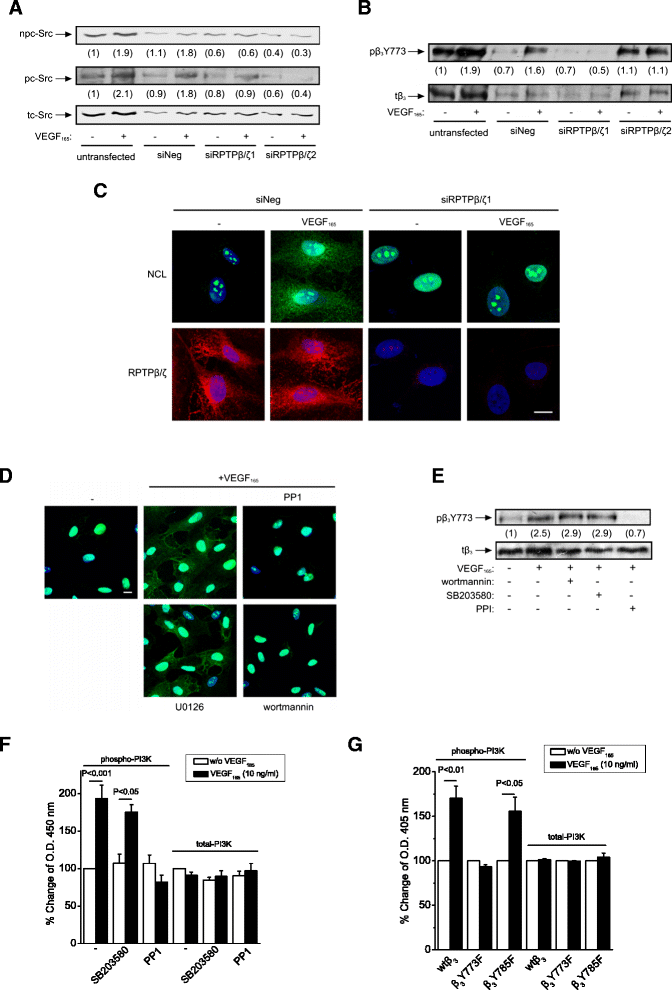
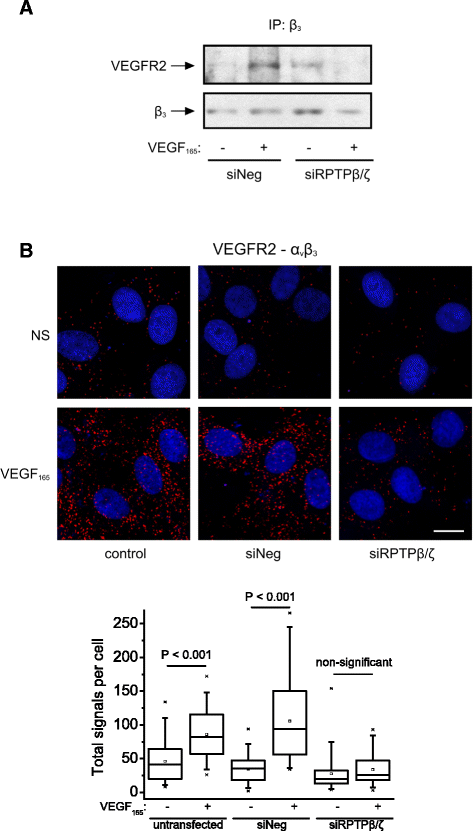
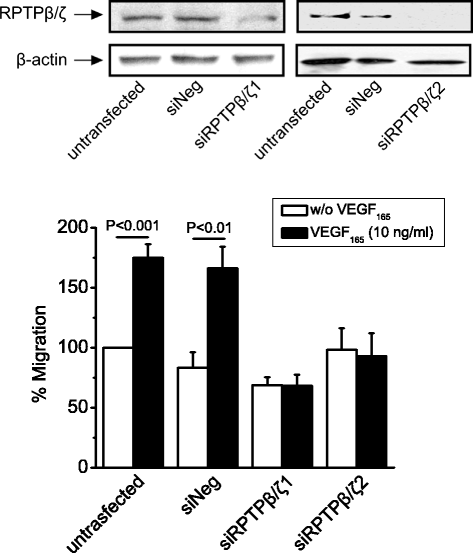
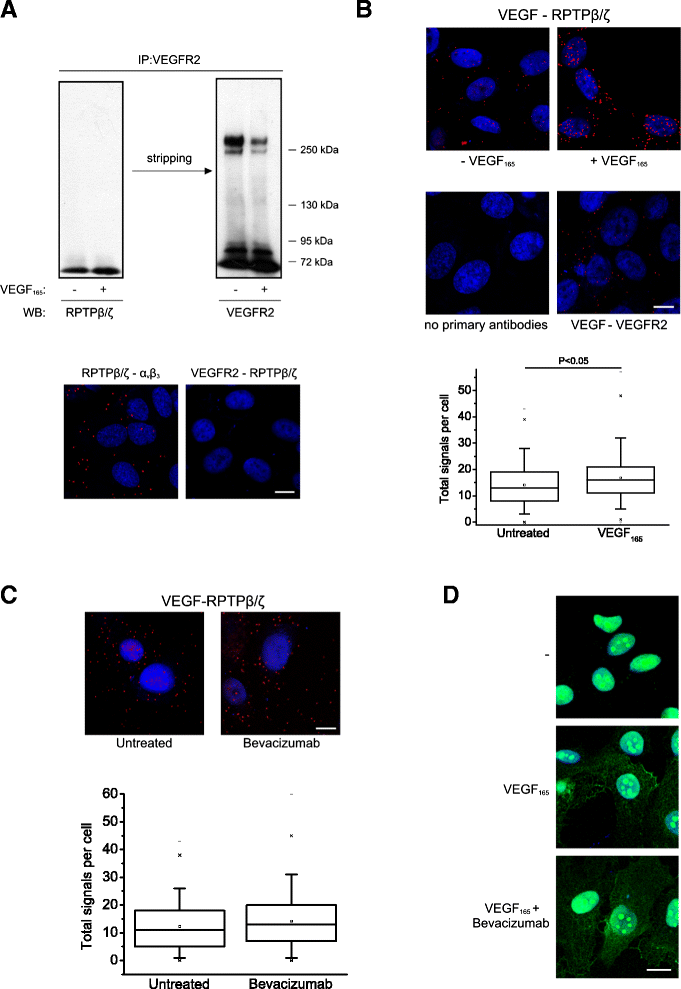

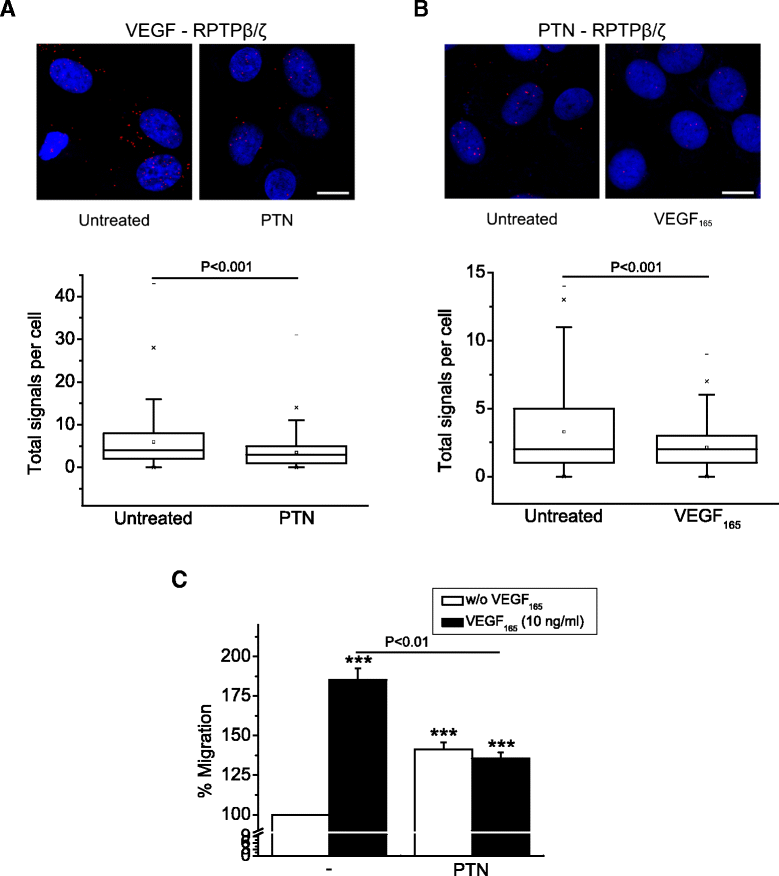
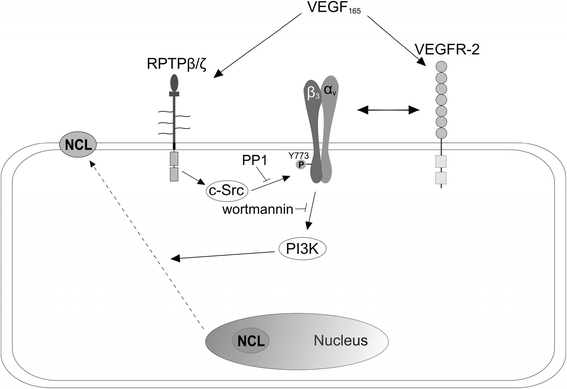
Similar articles
-
Vascular endothelial growth factor A (VEGF-A) decreases expression and secretion of pleiotrophin in a VEGF receptor-independent manner.Vascul Pharmacol. 2016 May;80:11-9. doi: 10.1016/j.vph.2016.02.008. Epub 2016 Feb 23. Vascul Pharmacol. 2016. PMID: 26924457
-
Pleiotrophin-induced endothelial cell migration is regulated by xanthine oxidase-mediated generation of reactive oxygen species.Microvasc Res. 2015 Mar;98:74-81. doi: 10.1016/j.mvr.2015.01.001. Epub 2015 Jan 10. Microvasc Res. 2015. PMID: 25582077
-
Cyclin-dependent kinase 5 mediates pleiotrophin-induced endothelial cell migration.Sci Rep. 2018 Apr 12;8(1):5893. doi: 10.1038/s41598-018-24326-x. Sci Rep. 2018. PMID: 29651006 Free PMC article.
-
Anaplastic lymphoma kinase: "Ligand Independent Activation" mediated by the PTN/RPTPβ/ζ signaling pathway.Biochim Biophys Acta. 2013 Oct;1834(10):2219-23. doi: 10.1016/j.bbapap.2013.06.004. Epub 2013 Jun 15. Biochim Biophys Acta. 2013. PMID: 23777859 Review.
-
Pleiotrophin and its receptor protein tyrosine phosphatase beta/zeta as regulators of angiogenesis and cancer.Biochim Biophys Acta. 2016 Dec;1866(2):252-265. doi: 10.1016/j.bbcan.2016.09.007. Epub 2016 Sep 29. Biochim Biophys Acta. 2016. PMID: 27693125 Review.
Cited by
-
A minimally invasive endovascular rabbit model for experimental induction of progressive myocardial hypertrophy.Hypertens Res. 2016 Dec;39(12):840-847. doi: 10.1038/hr.2016.66. Epub 2016 Jun 23. Hypertens Res. 2016. PMID: 27334064
-
Expression Changes and Impact of the Extracellular Matrix on Etoposide Resistant Human Retinoblastoma Cell Lines.Int J Mol Sci. 2020 Jun 17;21(12):4322. doi: 10.3390/ijms21124322. Int J Mol Sci. 2020. PMID: 32560557 Free PMC article.
-
Role of Protein Phosphatases in Tumor Angiogenesis: Assessing PP1, PP2A, PP2B and PTPs Activity.Int J Mol Sci. 2024 Jun 22;25(13):6868. doi: 10.3390/ijms25136868. Int J Mol Sci. 2024. PMID: 38999976 Free PMC article. Review.
-
Pleiotrophin, a multifunctional cytokine and growth factor, induces leukocyte responses through the integrin Mac-1.J Biol Chem. 2017 Nov 17;292(46):18848-18861. doi: 10.1074/jbc.M116.773713. Epub 2017 Sep 22. J Biol Chem. 2017. PMID: 28939773 Free PMC article.
-
Regulation of Pleiotrophin and PTPRZ1 Expression by Hypoxia to Restrict Hypoxia-Induced Cell Migration.Cancers (Basel). 2025 Apr 30;17(9):1516. doi: 10.3390/cancers17091516. Cancers (Basel). 2025. PMID: 40361445 Free PMC article.
References
-
- Koutsioumpa M, Papadimitriou E: PG receptors with phosphatase action in cancer and angiogenesis. In Extracellular Matrix: Pathobiology and Signalling. Edited by Karamanos N. Berlin/Boston: Walter de Gruyter GmbH and Co KG; 2012:813–823.
Publication types
MeSH terms
Substances
LinkOut - more resources
Full Text Sources
Other Literature Sources
Molecular Biology Databases
Miscellaneous

